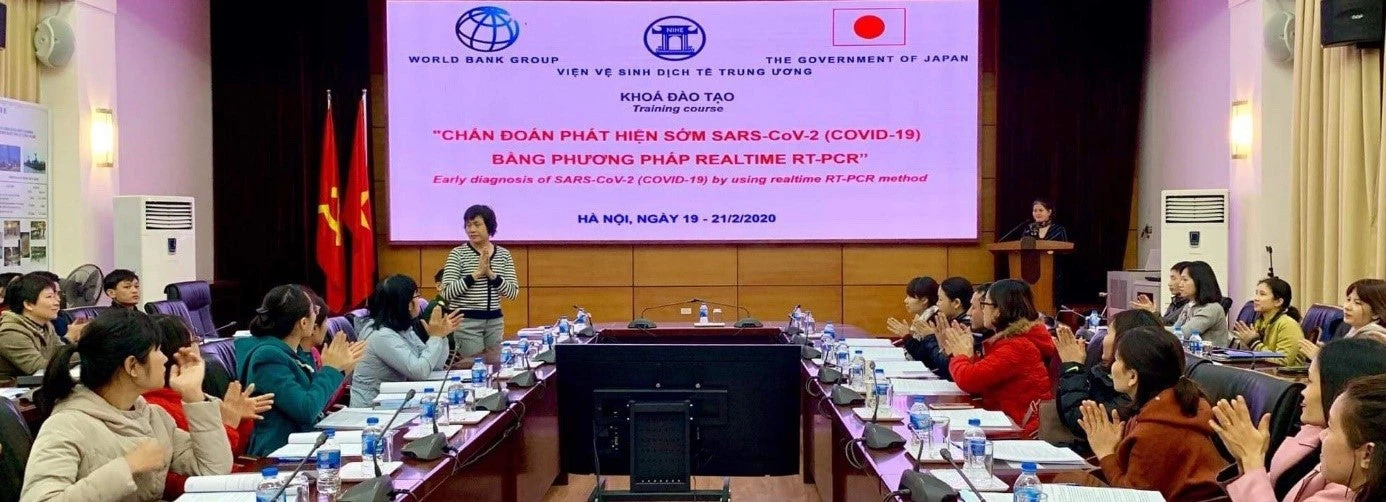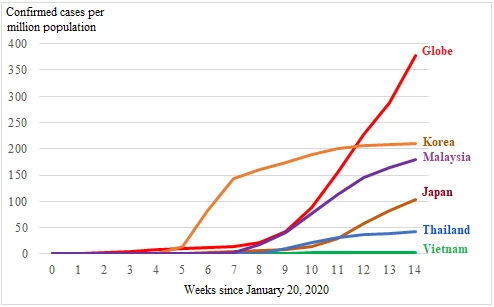 A training course on early diagnosis of COVID-19 in Hanoi, Vietnam. Photo: Anh Thuy Nguyen/World Bank
A training course on early diagnosis of COVID-19 in Hanoi, Vietnam. Photo: Anh Thuy Nguyen/World Bank
The SARS-CoV-2 virus which causes COVID-19 (coronavirus) has led to more than 3.1 million infections and 220,000 deaths globally. With even the wealthiest countries struggling to stop the spread, how can lower middle-income countries with limited resources bring the pandemic under control? With not a single confirmed death from COVID-19 to date, Vietnam’s approach offers useful insights.
The outbreak hit Vietnam early on. In late January, a man from Wuhan passed the coronavirus to his Vietnam-based son. Vietnam was thought to be highly vulnerable, as we have a 1,400 km border with China, busy cross-border travel and trade, a large population of 97 million people, and a lower middle-income economy. However, while many nations have seen cases soar, there have been only 270 confirmed cases (or 2.8 cases per million people) so far in Vietnam.
Figure 1: Prevalence of COVID-19 infections in Vietnam and selected countries
How has Vietnam kept its case count so low?
Vietnamese leadership began waging war on COVID-19 with early, decisive action. As soon as the first cases were detected, the government recognized COVID-19 as a major threat and took precautionary measures above and beyond World Health Organization (WHO) recommendations. These were implemented a week before the outbreak was recognized as a Public Health Emergency of International Concern and more than a month before WHO declared COVID-19 a global pandemic.
A national steering committee for COVID-19 control was established promptly and developed a multi-sectoral response plan. While many countries were debating their health and economic choices, Vietnam’s government made an unequivocal decision to prioritize health over economic growth , “fighting the epidemic as an enemy”. This commitment from the highest level of leadership paved the way for the Ministry of Health and other relevant ministries to implement unprecedented measures for the COVID-19 response.
Points of entry have been tightly controlled and suspected cases quarantined immediately. Vietnam was one of the first countries to halt passenger flights from high-risk areas and to quarantine international travelers. Since late January, the government has required all people arriving from China to submit a health declaration and undertake quarantine in government-controlled facilities for 14 days. These requirements were gradually expanded to those arriving from the Republic of Korea, the United States, and EU countries. Quarantine is largely in military facilities and is free of charge.
Testing is conducted both at entry to quarantine and upon exit. To date, 162 imported cases have been detected, which is about 60% of COVID-19 infections. International travel restrictions and institutional quarantine interrupted the influx of cases, giving the country more time to prepare.
Epidemic control teams have carried out targeted testing and aggressive contact tracing. The National Institute of Hygiene and Epidemiology succeeded in culturing and cultivating the SARS-CoV-2 virus early, enabling domestic institutions to produce test kits. The Ministry of Health initially targeted only those with travel histories for testing, along with close contacts of confirmed cases and people presenting with COVID-19 symptoms. Testing has recently been expanded to hot spot communities and at-risk settings such as wholesale markets in Hanoi and industrial zones in Ho Chi Minh City.
At least 110 laboratories across the country can perform real-time polymerase chain reaction testing for COVID-19 diagnosis, with a capacity of 27,000 samples per day. As of April 30, Vietnam had conducted 261,004 tests, with 967 tests per positive case or 2691 tests per million population.
Local authorities are taking a four-tier approach to contact tracing and isolation. Localized centers for disease control and preventive health facilities are closely collaborating with hospitals in case detection, isolation and treatment. Confirmed cases are considered tier one and must be isolated and treated in health facilities. Home-based isolation of confirmed cases is not allowed in Vietnam, to prevent transmission to family members. Currently, hospitals and health centers face neither overwhelming demand nor supply shortages, so sufficient resources remain available for all COVID-19 patients.
Tier two is for the close contacts of confirmed cases, who must undertake testing and government-run quarantine. Those in tier three have had close contact with tier two cases: they must self-isolate at home. The fourth tier involves isolation of entire communities. Local authorities have isolated two villages, a commune, and a hospital.
Over 134,000 people had undertaken institutional quarantine and/or isolation in Vietnam by mid-April. Vietnam’s targeted testing, aggressive contact tracing and multi-tier isolation system has greatly contributed to its success in controlling COVID-19.
The public is well-informed of personal protective measures. The Ministry of Health informs the public of positive cases and potential exposures, and has provided guidelines for disease prevention on its websites. A government-run media campaign, including a viral music video, has promoted personal protective behaviors, while public and private telecom companies have collectively sent 3 billion messages on COVID-19 prevention to mobile phone users.
Public compliance with precaution measures, including social distancing, is high. Wearing face masks is mandated in public places, and alcohol-based hand sanitizers are widely available. Religious sites and schools have been closed for three months.
The private sector has stepped up. Factories have shifted their focus to manufacturing medical supplies, helping the health system avoid shortages of personal protective equipment and ventilators. Philanthropists have installed “rice ATMs” to feed vulnerable people amid an economic slowdown.
A history of pandemic preparedness
Vietnam’s relative success is the result of persistent efforts in pandemic preparedness. Since the SARS outbreak in 2003, Vietnam has continued to strengthen its national capacity for emerging infectious disease control, including with World Bank support.
From 2005 to 2014, the World Bank financed a series of three operations for Avian and Human Influenza Control and Preparedness, which enhanced disease surveillance and response systems and curative care preparedness.
More recently, the Bank has supported the Vietnam Health Security Financing Assessment; risk communication situation analysis; and training on COVID-19 surveillance, diagnostic, care and treatment. Four regional health system support projects in the Mekong Delta region, Northern Upland region, Central North region, North East and Red River Delta region from 2006 to 2020 have strengthened diagnosis and treatment capacities of the local health networks. The Hospital Waste Management Support Project has improved infectious waste management and occupational health in more than 200 hospitals across the country.
Early, decisive and transparent actions by the country’s leadership, along with the engagement and solidarity of citizens, have been key to Vietnam’s success in combatting COVID-19 to date. As restrictions are gradually loosened, we are moving to a “new normal” while remaining vigilant to minimize the next coronavirus wave. In the words of Vietnam’s Deputy Prime Minister, “we may have won one battle, but the war is still continuing.”
The author would like to thank Son Nam Nguyen, Caryn Bredenkamp, Keiko Inoue, Anh Thuy Nguyen, and Huong Lan Dao from the Vietnam health team for valuable contributions to this blog.



Join the Conversation